25.07.2023
China is sending zebrafish to the Tiangong space station
The experiments using the fish will aid research into mitigating bone loss in astronauts.
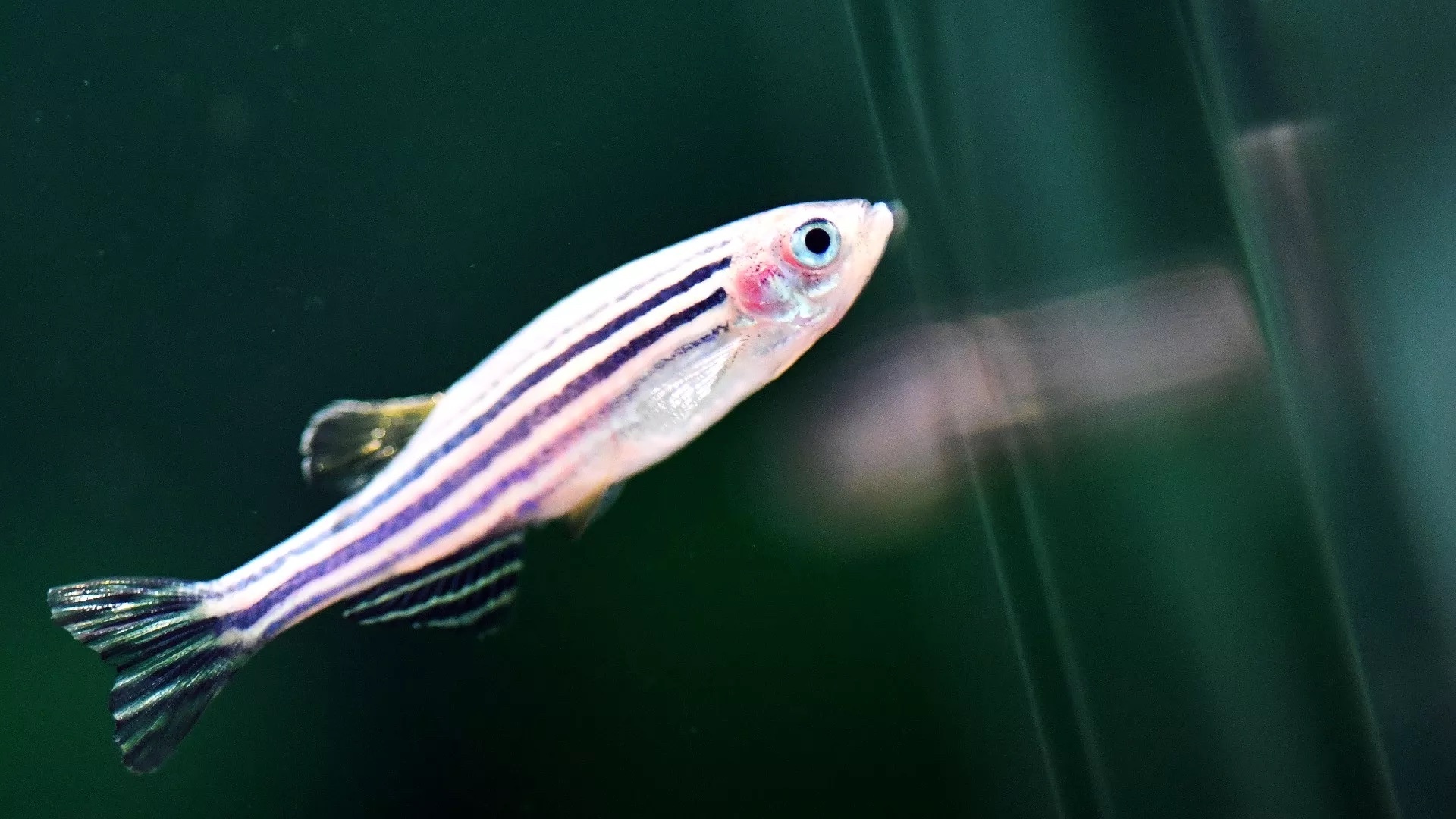
A zebra danio, or zebrafish, swims in a tank in a research institute in Wuhan in central China's Hubei province Thursday, April 22, 2021. (Image credit: Feature China/Future Publishing via Getty Images)
China is planning to send zebrafish to its space station in the future.
The small fish species will be sent into orbit on China's Tiangong space station as part of research into the interaction between fish and microorganisms in a small closed ecosystem, Shanghai-based Guancha.cn reported. The experiment will also aid research into bone loss in astronauts.
Zhang Wei, assistant to the commander-in-chief of China's manned space engineering space application system, told Chinese media of the plan during a Space Station Science and Application Project Solicitation Seminar in Beijing on July 10. Further information regarding the timeline of the experiment and its aquatic apparatus was not disclosed.
It will not be the first time fish have been sent to space. NASA's Aquatic Habitat, or AQH, designed to study how microgravity impacts marine life, was sent to the International Space Station in 2012. It hosted a small school of medaka, a small, freshwater fish native to Japan.
Zebrafish, or Danio rerio, were earlier sent to the Soviet Union's Salyut 5 space station in 1976 aboard the Soyuz 21 mission. Soviet cosmonauts conducting experiments with the fish found that the Zebrafish appeared to modify some of their behaviors in response to living in microgravity.
Sending animals to space meanwhile dates back to 1947, before the Soviet space dog Laika took her much more famous flight on Sputnik 2 in 1957. Laika tragically overheated and died just hours into her flight.
Quelle: SC
----
China Focus: China's space lab starts formal operation

China's orbiting Tiangong space station, which functions as a national space laboratory, has been put into operation, pushing forward space applications and achieving fruitful results, according to the China Manned Space Agency.
A total of 110 in-orbit science research and application projects have been implemented, involving space life science and human body research, microgravity physics, and new space technologies, making multiple world's firsts, said Lin Xiqiang, the agency's deputy director, at a press conference on Friday.
The space lab also led to the establishment of a Chinese near-Earth space science and application system. Lin highlighted some system features, including its advanced lab platform for research and application of many space science-related disciplines and its strong in-orbit experimental support that allows taikonauts, especially payload experts, to conduct various operations.
Almost 100 TB of original experimental data have been acquired, and nearly 300 experimental samples returned, including the seeds of rice that had undergone a 120-day life cycle in the space station, he added.
The life-cycle growth experiment of rice is the first in the world, and the discovery of functional gene regulation would promote the breeding of new rice varieties, said Wang Qiang, deputy commander-in-chief of the space application system of China's manned space program.
A new alloy material was another breakthrough obtained on the space station, which might be applied in aerospace, nuclear power and other industries, said Wang.
In space medical experiments, the artificial vascular-tissue chip research and a visualization study on the influence of weightlessness on intracellular calcium signals have been made, both of them for the first time in the world, said Li Yinghui, deputy chief designer of the astronaut system of China's manned space program.
The experiment of the Stirling thermoelectric converter has laid a technical foundation for the country's future manned lunar exploration and deep space missions, said Guo Pei, a China Academy of Space Technology designer.
A two-photon microscope was used to obtain three-dimensional images of the astronaut's skin during spaceflight, also for the first time in the world, forming a new tool for in-orbit health monitoring, said Lin.
Many research results obtained in the space lab have brought benefits to Earth.
According to Lin, over 4,000 items of achievements obtained through China's manned space program have been used to serve the national economy and people's livelihood.
Lin added the study results of space life science now apply to biomaterials, medicine, medical treatment, and agricultural technologies.
Also, the research results in microgravity fluids, combustion and materials science contribute to improving manufacturing and processing techniques.
More than 3,000 space breeding experiments have been carried out on spaceflight missions, cultivating 240-plus varieties of staple grains and 400-plus new vegetable, fruit, plant and flower varieties. This has resulted in an annual grain output increase of 2.6 billion kilograms.
Achievements of the project are also widely applied in natural resources and ecological environment protection, disaster prevention and reduction, and public services, helping sustain the modernization of social governance, Lin said.
Quelle: Xinhua
+++
China's space station expected to make scientific discoveries
The orbiting Tiangong space station is expected to obtain pivotal scientific discoveries and innovative achievements in the future, the China Manned Space Agency's spokesperson Lin Xiqiang said on Friday.↳
China's space station has entered a phase of application and development that will span more than 10 years after its construction was completed in 2022.↳
Lin said it could hopefully produce groundbreaking scientific discoveries on cosmology, dark matter and dark energy, galaxies, active galactic nuclei, the Milky Way and its close galaxies, star formation and evolution, and exoplanets.↳
The space station's objectives in frontier research are "the origin and evolution of the universe, the nature of matter, and the long-term survival of human beings in space," said Lin.↳
The space lab's ultra-cold atomic physics experiment platform will prepare the quantum gas close to absolute zero, which cannot occur on the ground.↳
Also, the in-orbit research on stem cells, organ chips, protein crystallization, and synthetic biology manufacturing could bring new possibilities for regenerative medicine, precision medicine, and drug discovery, said Lin.↳
He added that new instruments concerning mammal breeding and brain science will eventually be installed in the space station.
Quelle: Xinhua
+++
China Focus: China's space station to carry out international payload experiments
Experiments of the first batch of international payloads selected under cooperation between China and the United Nations Office for Outer Space Affairs (UNOOSA) will soon take place on the Tiangong space station, the China Manned Space Agency said on Friday.
An agency spokesperson, Lin Xiqiang, made the remarks at a press conference. He added that ten space application projects, jointly implemented with the European Space Agency (ESA), are in steady progress.
"We have conducted various exchanges and cooperation with space agencies of many countries and regions as well as international organizations involving spacecraft technology, space science experiments, and astronaut selection and training," said Lin.
Since the implementation of its manned space program, China has sent people overseas to participate in weightless aircraft training, cave training and the Mars500 study. It has also led several large international cooperation projects, including astronauts' sea survival training and research on cardiovascular function in weightlessness.
Ye Guangfu, a member of Shenzhou-13 crew, was the first taikonaut to complete cave training through international cooperation.
"China has so far signed cooperation framework agreements with the UNOOSA, ESA and space agencies of Russia, France, Germany, Italy and Pakistan," said Lin, highlighting that some have been successfully implemented, and some space station-related cooperation projects are under preparation.
"We welcome astronauts from other countries to carry out experiments on the Chinese space station," Lin added.
Preparations for foreign astronaut training are proceeding as planned.
Quelle: Xinhua
+++
Flagship Chinese space telescope to orbit with space station
China is currently developing a large-scale space-survey telescope that is expected to bring pioneering scientific results after it is placed in orbit alongside the country's space station, a spokesperson of the China Manned Space Agency said Friday.
Lin Xiqiang, also deputy director of the agency, said at a press conference that the Chinese Survey Space Telescope, also known as the Chinese Space Station Telescope (CSST) and Xuntian Space Telescope, is expected to make breakthroughs in cosmology, dark matter and dark energy, galaxies and active galactic nuclei, Milky Way and neighboring galaxies, star formation and evolution, and exoplanets.
Lin said the high-resolution telescope will take deep-field survey observations with an area of 17,500 square degrees, as well as fine observations of different types of celestial bodies.
He said that the telescope, an important part of China's space station, can obtain high-definition panoramic views of the universe. It has roughly the same spatial resolution as the Hubble Space Telescope, but its field of view is more than 300 times larger than Hubble's.
The telescope will stay in the same orbit as the space station for long-term independent flight and observations, and will dock with the space station temporally for supply, maintenance and upgrading, Lin added.
Quelle: Xinhua
----
Update: 13.09.2023
.
China's Tianzhou-5 cargo spacecraft separates from space station combination
After completing all assigned tasks, the Tianzhou-5 cargo spacecraft separated from the space station combination at 4:46 p.m. Monday (Beijing Time) and switched to independent flight, according to the China Manned Space Agency (CMSA).
The cargo craft will re-enter the atmosphere under control on Tuesday. Most of its components will be burned up and destroyed during the process, while a small amount of debris will fall into designated safe waters in the South Pacific, the CMSA said.
Tianzhou-5 was launched into orbit on Nov. 12, 2022 from the Wenchang Spacecraft Launch Site in the southern island province of Hainan.
The cargo craft delivered supplies for the three astronauts of the Shenzhou-15 mission to stay in orbit for six months. It also sent propellant and experiment facilities, including the Macao Student Science Satellite 1, space hydrogen-oxygen fuel cells, and space high-energy particle detection payloads.
During its orbital flight, it separated from the space station combination on May 5, re-docked with the space station after a 33-day independent flight, and continued to carry out space technology experiments.
Quelle: Xinhua
+++
China Focus: Tianzhou-5 cargo craft re-enters atmosphere after completing mission
China's Tianzhou-5 cargo craft re-entered the atmosphere in a controlled manner at 9:13 a.m. (Beijing Time) Tuesday, according to the China Manned Space Agency.
Most of the spacecraft's components burned up during the re-entry, and a small amount of its debris fell into the predetermined safe waters of the South Pacific.
The Tianzhou-5 separated from the orbiting Tiangong space station combination at 4:46 p.m. Monday and switched to independent flight.
Launched on Nov. 12, 2022 from the Wenchang Spacecraft Launch Site in the southern island province of Hainan, the Tianzhou-5 was loaded with propellants, materials for scientific experiments and supplies for taikonauts.
According to the agency, many application projects carried into space by the Tianzhou-5 are progressing smoothly and have achieved fruitful results. Among them is the Macao Student Science Satellite 1, which was stowed in the cargo craft before being released into orbit on Dec. 18, 2022.
This satellite is operating stably in orbit, functioning as a space-based scientific practice platform for amateur radio enthusiasts in the Guangdong-Hong Kong-Macao Greater Bay Area, on both sides of the Taiwan Strait and around the world. It has vigorously promoted the in-depth cooperation and exchanges between the Chinese mainland and Macao in space science popularization and education, the agency noted.
The in-orbit test of space hydrogen-oxygen fuel cells is another experimental achievement onboard the Tianzhou-5, providing data and theoretical support for China's future manned lunar explorations.
Other key payloads include the space high-energy particle detection equipment, which completed an extravehicular mission.
At present, three batches of application projects have been carried by Tianzhou into space. The agency said future manned space missions will continue to open its cargo craft payloads to the public.
Quelle: Xinhua
----
Update: 6.10.2023
.
China to send new modules and co-orbiting spacecraft to Tiangong space station
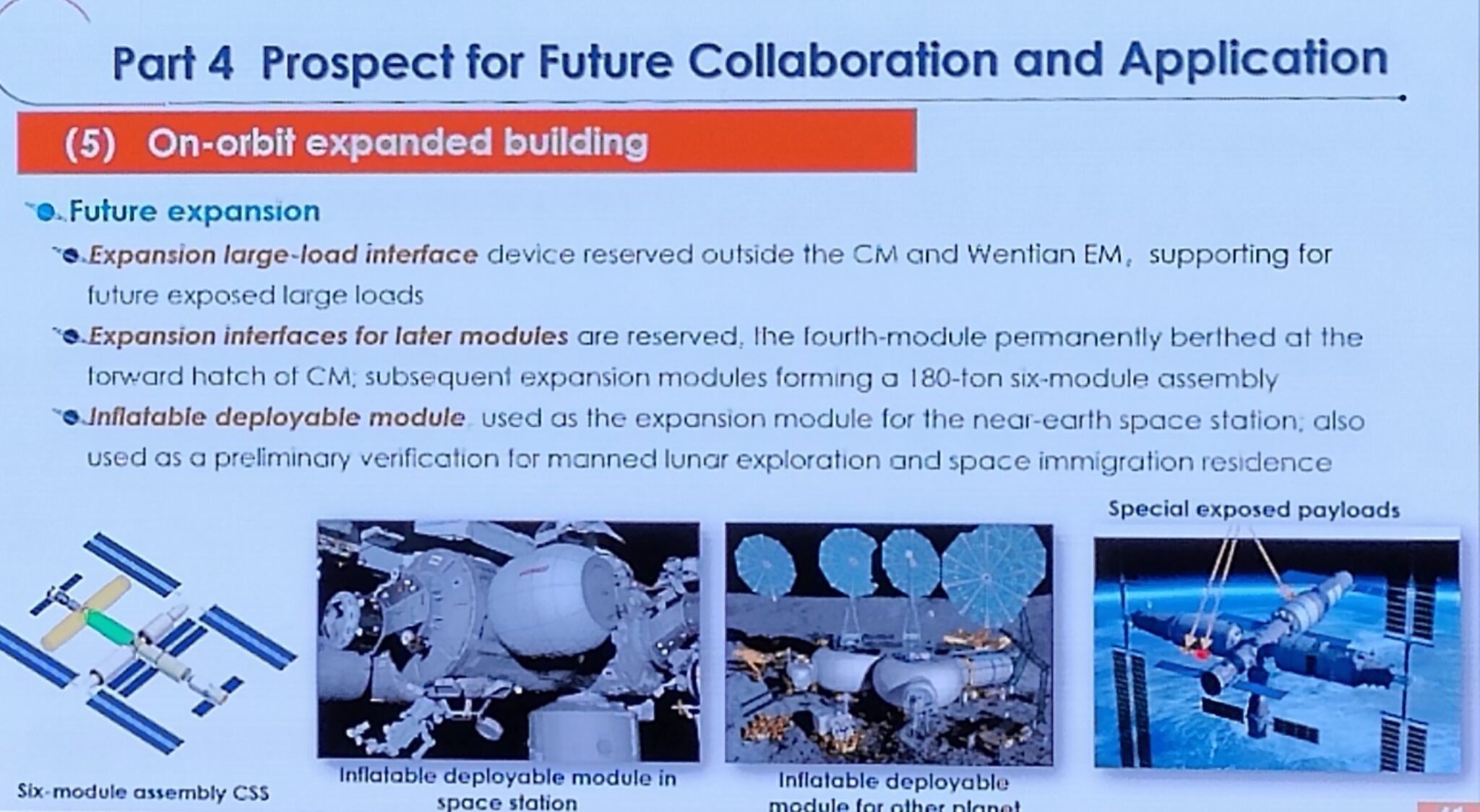
BAKU, Azerbaijan — China will send new modules to its Tiangong space station in coming years to expand the outpost’s volume and capabilities.
Future plans for Tiangong were presented at the 47th International Astronautical Congress in Baku Oct. 4. Zhang Qiao of the China Academy of Space Technology (CAST) presented plans to expand Tiangong from three to six modules.
“We will build a 180 tons, six-module assembly in the future,” Zhang said. Tiangong currently has three modules, each with a mass of around 22 tons.
A multi-functional expansion module with six docking ports will first be launched in the coming years to allow this expansion. This will dock at the forward port of the Tianhe core module. Full size modules can then be added to Tiangong. SpaceNews understands that the timeline for such launches is around four years from now.
An expanded Tiangong would be just over a third of the mass of the roughly 450-metric-ton International Space Station (ISS). The first module for the ISS, Zarya, was launched in 1998. Partners in the program are seeking to maximize the use of the aging station through 2030.
Zhang also stated that expansion interfaces for Tianhe and the Wentian experiment module are being developed to host large external payloads.
Inflatable modules are also being developed. These will serve both as potential habitats and preliminary verification for crewed lunar exploration.
CAST is an arm of China’s state-owned main space contractor, CASC. The academy develops and manufactures spacecraft including the modules for Tiangong and would likely be involved in development of new modules.
The plan for the basic, three-module Tiangong (“Heavenly Palace”) was initially stated to be a lifetime in orbit of no less than 10 years.
A Hubble-class co-orbiting space telescope, named Xuntian, is planned to be launched around 2024. It will be able to dock with Tiangong for maintenance, repairs, refueling and upgrades.
Zhang’s presentation also noted that more spacecraft will “probably fly co-orbitally with CSS [Chinese space station] to receive on-orbit services.”
The CSS will gradually play an important role as a “space home port,” according to Zhang.
Other improvements planned for Tiangong include 3D printers and developing intelligent robots, upgrading connectivity and robotic arms, and developing a space debris observation, detection and warning system. A digital twin of the station will also be constructed.
The expansion of the station would come at a time when China is working on several other expensive and challenging space projects. These plans include sending its first astronauts to the moon before 2030, while also working to construct an International Lunar Research Station in the 2030s. China is also working on a Mars sample return mission. This will be a more simple mission in comparison to the NASA-ESA MSR project, yet will still be incredibly complex. The latter project meanwhile has come under budgetary scrutiny in the U.S.
The growing scope of China’s space activities reflects an apparent increase in resources for the space sector, but may also create potential logistical, technical or budgetary challenges.
Experiments and cooperation
Lyu Congming, deputy chief designer of Space Utilization System of China’s human spaceflight program, told the audience that more than 100 scientific research projects for Tiangong have been initiated. Of these, 65 have been implemented with 48 ongoing.
Lyu added that international cooperation through the United Nations Office for Outer Space Affairs (UNOOSA) has been carried out, with a first round of experiments already selected. A new round of calls for proposals is expected soon and periodically after this. Lyu also highlighted cooperation with the European Space Agency.
China’s human spaceflight agency, CMSEO, has been looking at opening Tiangong to various commercial purposes including tourism. It also recently selected four proposals to proceed to a detailed design study phase for developing low-cost supply missions to the space station.
The presentations Wednesday also stated numerous times that China is looking for cooperation of various types with Tiangong. This includes collaboration at the payload, technology and module levels.
CMSEO stated earlier this year that it was about to start selecting international astronauts to travel to the space station. No update on the process was provided.
Quelle: SN
----
Update: 27.10.2023
.
China's Shenzhou 17 astronauts arrive at Tiangong space station
The trio reached Tiangong early on Thursday morning (Oct. 26), about 6.5 hours after lifting off.
China's newest astronaut crew has arrived at its orbital destination.
The three spaceflyers of the Shenzhou 17 mission reached China's Tiangong space station early Thursday morning (Oct. 26), just 6.5 hours or so after lifting off atop a Long March 2F rocket from the Gobi Desert.
The trio soon joined the three Shenzhou 16 astronauts already aboard Tiangong, who greeted the newcomers with hugs as they came through the station's hatch. The six spaceflyers then lined up to relay a message to Mission Control and the rest of us back on Earth.
"Build a dream at the Tiangong space station and continue to work hard," they said in unison (in Mandarin; translation by Chinese broadcaster CCTV, which livestreamed the event). "China's space station is always worth looking forward to."
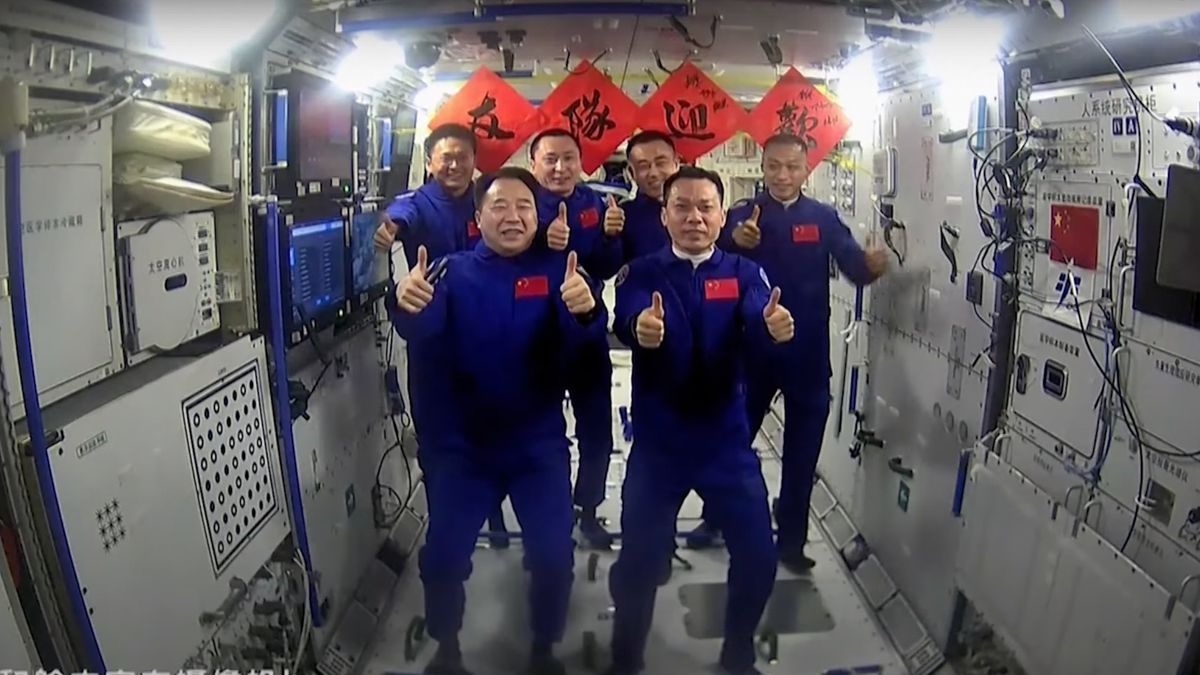
The astronauts of China's Shenzhou 16 and Shenzhou 17 missions celebrate the latter crew's arrival on the Tiangong space station on Oct. 26, 2023. (Image credit: CCTV
The Shenzhou 17 crew consists of mission commander Tang Hongbo, 48, and former fighter pilots Tang Shengjie, 34, and Jiang Xinlin, 35. They're the youngest group ever to visit Tiangong, which China began assembling in low Earth orbit in April 2021 and finished about 18 months later.
The Shenzhou 17 astronauts will live aboard the orbiting lab for the next six months, performing a variety of scientific experiments and maintenance tasks. Among those anticipated jobs is a spacewalk designed to inspect and potentially repair Tiangong's solar arrays, which have suffered a few debris impacts and/or micrometeoroid strikes during their short orbital lives.
"Currently, space debris is increasing, so the impacts of small space objects on long-duration operational spacecraft are inevitable," Lin Xiqiang, deputy director of the China Manned Space Agency, said during a Shenzhou 17 prelaunch press conference on Wednesday (Oct. 25).
"Previous inspection revealed that the space station's solar panels had also been hit several times by tiny objects in space, suffering minor damage, of course which was taken into account during our design," Lin added.
Shenzhou 17's arrival marks the beginning of the end for the Shenzhou 16 mission, which reached Tiangong in late May. The Shenzhou 16 astronauts — Jing Haipeng, Zhu Yangzhu and Gui Haichao — are scheduled to return to Earth on Oct. 31.
Tiangong, which is about 20% as massive as the International Space Station, is a T-shaped structure consisting of three modules. Shenzhou 17 is the seventh crewed mission to make it to the Chinese outpost to date.
Quelle: SC
+++
Shenzhou-17 crew arrives at Tiangong space station
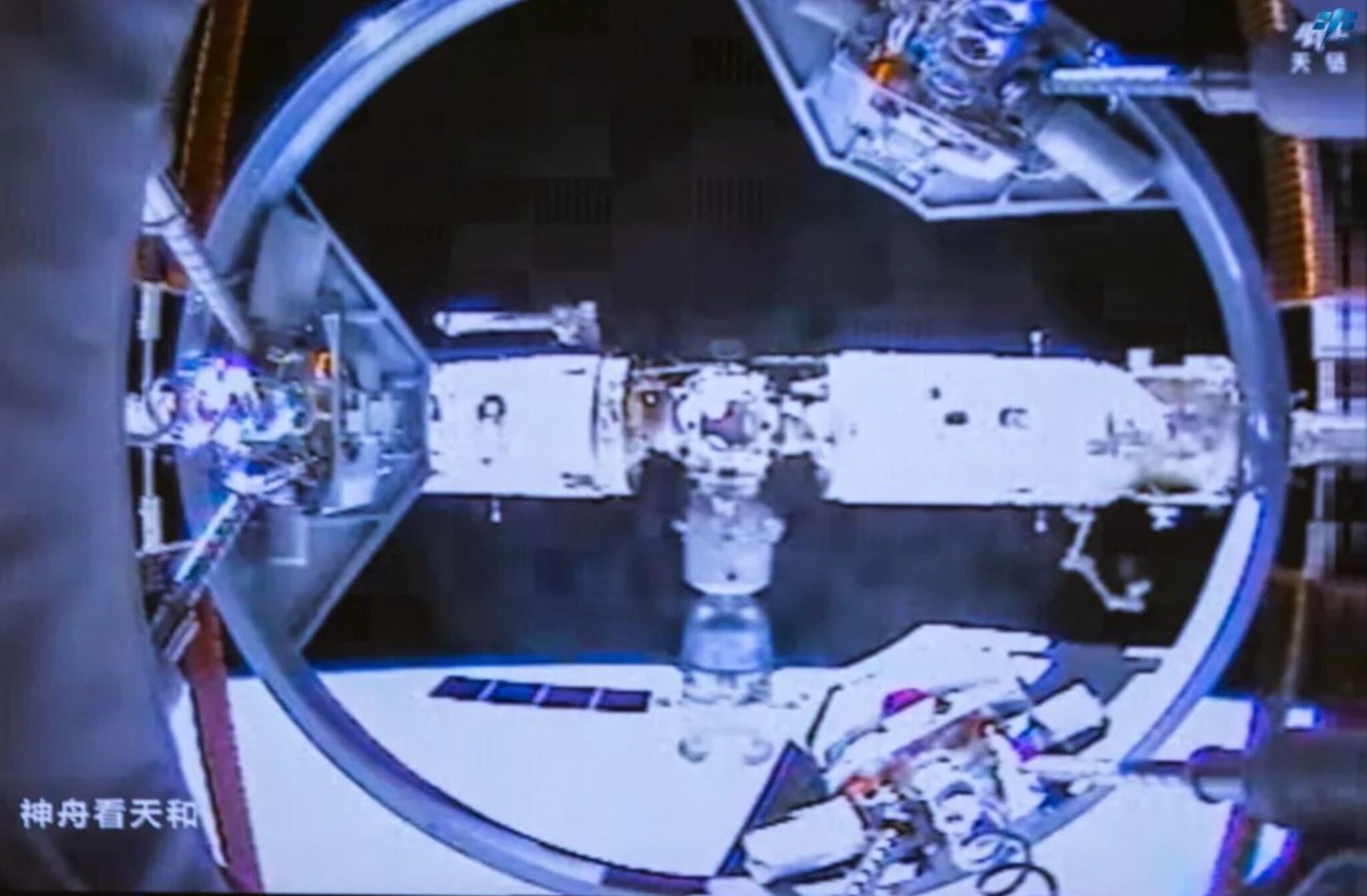
A view of Tiangong from the Shenzhou-17 spacecraft as it approaches the forward docking port. Credit: CMSEO
HELSINKI — Three new astronauts have arrived at China’s Tiangong space station following launch from the Gobi Desert late Wednesday.
A Long March 2F rocket tipped with the Shenzhou-17 spacecraft lifted off from the Jiuquan Satellite Launch Center in the Gobi Desert at 11:14 p.m. Eastern, Oct. 25 (0314 UTC, Oct. 26). The spacecraft separated from the upper stage 10 minutes later. Zou Lipeng, commander of the Jiuquan Satellite Launch Center, announced the launch a complete success.
Rendezvous and docking at Tiangong’s forward docking port was completed 6.5 hours later, at 5:46 a.m. Oct. 26, China’s human spaceflight agency confirmed.
The Shenzhou-17 astronauts will soon be greeted aboard Tiangong by the Shenzhou-16 crew, who will hand over control of the station and depart for Earth Oct. 31.
The Shenzhou-17 crew is composed of commander Tang Hongbo, a veteran of Shenzhou-12—the first mission to visit Tiangong’s Tianhe core module in 2021—and former air force pilots Tang Shengjie and Jiang Xinlin. The trio will spend around six months aboard Tiangong, or Heavenly Palace in English.
Tang was recruited as part of a second batch of Chinese astronauts in 2010. The latter pair were selected as members of China’s third batch of astronauts in September 2020. A fourth selection round is currently underway, and could include, for the first time, astronauts from Hong Kong or Macau.
Shenzhou-17 is China’s sixth crewed mission to Tiangong, and the country’s 12th overall. The astronauts will perform maintenance tasks, conduct science experiments and outreach events.
They will also perform a first extravehicular activity to carry out experimental maintenance operations outside Tiangong, according to Lin Xiqiang, deputy director of the China Manned Space Engineering Office (CMSEO), speaking at a press conference Oct. 25.
Lin stated that preliminary inspections found that the space station’s large solar arrays were repeatedly hit by tiny particles, causing minor damage.
Shenzhou-17 will receive the Tianzhou-7 cargo spacecraft to Tiangong in the first half of 2024. They will hand over the station to the Shenzhou-18 crew at the end of their six months in orbit.
Evolving space station plans
China approved its plan to develop human spaceflight capabilities in 1992, with the ultimate aim of constructing a modular space station. China launched its first astronaut into orbit in October 2003 with Shenzhou-5, and completed Tiangong in late 2022. The space station was initially stated to consist of three modules and operate for 10 years.
China is now planning to expand Tiangong with a multipurpose module. This will allow further full-sized modules to dock with the orbital outpost. The lifespan could also be extended, keeping it in orbit long after the International Space Station is expected to be deorbited.
CMSEO also solicited proposals for a low-cost cargo transportation system to Tiangong. Many of the proposals are seeking to leverage commercial launch vehicles, according to CMSEO.
The agency also stated this year it would begin selecting international astronauts for visits to Tiangong. The station currently has a long-duration capacity of three astronauts, with crews in orbit for six months at a time.
It is unknown if international astronauts would stay aboard for a short stay, during crew handover, and see one Chinese astronaut remain in orbit for the duration of two missions, or participate for a full duration mission.
An expanded Tiangong would mean the station could host more astronauts at one time. The country’s new generation crew spacecraft and launch vehicle, expected to fly in 2027 for the first time, would allow more astronauts to fly to Tiangong than the three-person capacity Shenzhou.
China is also planning to send a pair of astronauts to the moon before 2030. Tiangong will provide the country with long-duration spaceflight experience. Yang Liwei, who flew on the historic Shenzhou-5 mission, recently told state media that the astronauts for the mission would be selected from those with prior spaceflight experience.
Quelle: SN
+++
Shenzhou-17 astronauts enter space station, complete handover in four days
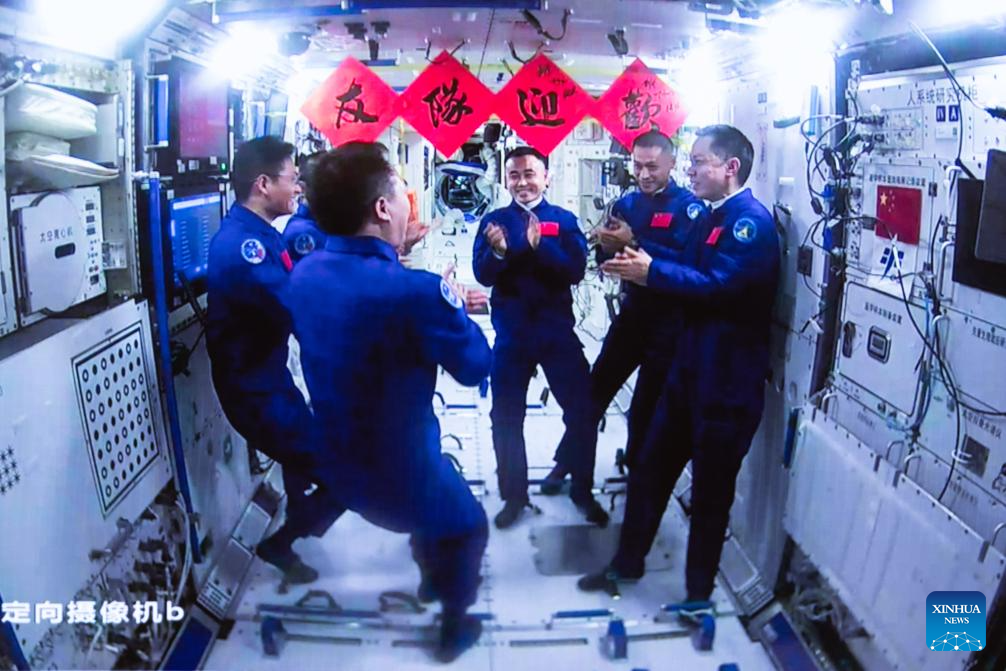
This image captured at Beijing Aerospace Control Center on Oct. 26, 2023 shows the Shenzhou-16 and Shenzhou-17 crew talking with each other inside China's space station. (Photo by Han Qiyang/Xinhua)
The three astronauts aboard China's Shenzhou-17 spaceship have entered the country's space station and met with another astronaut trio on Thursday, starting a new round of in-orbit crew handover.
The Shenzhou-16 crew opened the hatch at 7:34 p.m. (Beijing Time). The three space station occupants greeted the new arrivals, and they took group pictures.
Tang Hongbo, commander of the Shenzhou-17 mission, experienced the historic moment as one of the first Chinese astronauts to China's space station in June 2021 when launched into orbit on the Shenzhou-12 mission.
Now, the space complex Tang revisits has been extended into a versatile space lab with two additional modules and more sophisticated experimental facilities. He also set a new record for the shortest interval between two spaceflight missions by Chinese astronauts.
The space get-together of the two crews kicked off the third in-orbit crew rotation in China's space station.
According to the China Manned Space Agency, the six astronauts will live and work together for about four days to complete planned tasks and handover work.
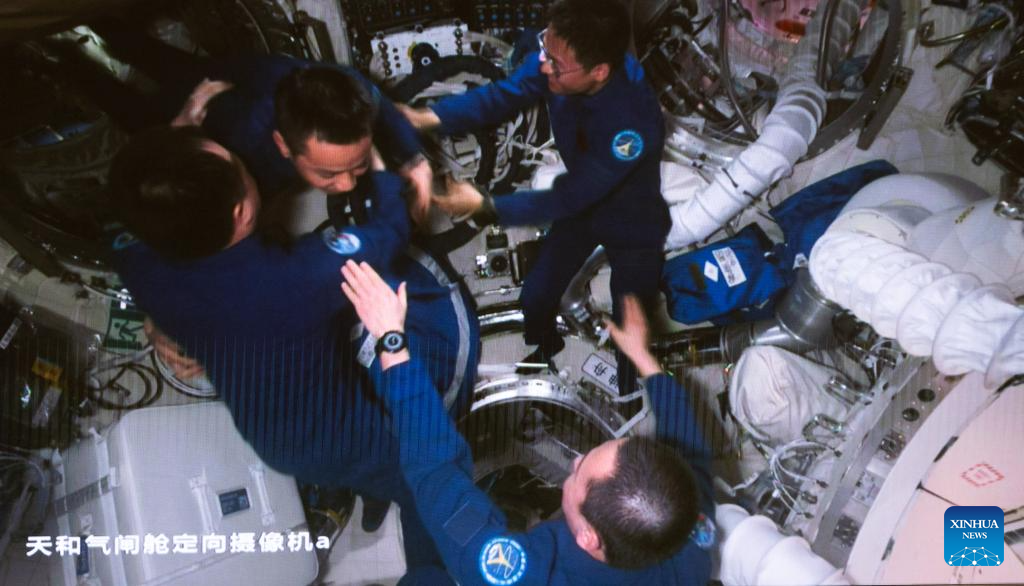
Quelle: Xinhua
----
Update: 31.10.2023
.
China's Shenzhou-16 astronauts ready to return after in-orbit crew handover
The Shenzhou-16 taikonauts handed over control of the Tiangong space station to the newly arrived Shenzhou-17 crew on Sunday, said the China Manned Space Agency.
The two crews held a handover ceremony after the Shenzhou-16 taikonauts had completed all set tasks. They are due to return to Earth on Oct. 31 aboard the Shenzhou-16 spaceship.
The Dongfeng Landing Site, located in north China's Inner Mongolia Autonomous Region, is preparing for the return of Shenzhou-16 from space.
This will be the fifth mission the landing site has conducted to recover a manned spacecraft and the crew.
Ground personnel have undergone various search and rescue exercises for the upcoming mission, the landing site said.
Quelle: Xinhua
----
Update: 10.11.2023
.
Surprise! China's space station has a 3rd, mini robotic arm. Watch it in action
Tiangong also boasts a highly capable pair of larger arms on its exterior.
China's space station has a third, smaller robotic arm operating inside to assist astronauts, we now know.
The Tiangong space station notably has a pair of robotic arms on its exterior. These arms — which are 33 feet (10 meters) and 16.4 feet (5 m) long, respectively, and can "crawl" on the outside of Tiangong — have helped with the space station's construction and assisted astronauts during spacewalks.
Within the space station's Mengtian experiment module, however, there is a third, much smaller, dextrous arm that can assist everyday activities, Chinese broadcaster CCTV recently revealed.

The miniature robotic arm inside China's Tiangong space station helps astronauts with science experiments and other activities. (Image credit: CCTV
The interior arm is about 27.5 inches to 31.4 inches (70 to 80 centimeters) long, and its operational accuracy can reach 0.004 inches (0.1 millimeters). It can help astronauts with maintenance, installation and adjustment operations, according to CCTV. It can also prove valuable for space experiments.
"For example, after the external payloads are taken into the cabin, including some of the biological loads, when there is need to sterilize them after the experiments, we can change the end tools fixed to the robotic arm to do the work," said Zhang Lu, a researcher at the Technology and Engineering Center for Space Utilization under the Chinese Academy of Sciences.
"We could have different end tools installed on the robotic arm to perform different tasks in the years to come. If there are some tedious tasks like turning screws or sampling, we can replace the end tool with a small clamping jaw, or an electric scissors, to complete the operation," Zhang said.
China completed the construction of the three-module Tiangong space station in late 2022. The sixth and latest crew arrived aboard the Shenzhou 17spacecraft late last month.
China wants to keep Tiangong permanently occupied for at least a decade and is looking to expand the orbital outpost in the coming years.
Quelle: SC
----
Update: 24.11.2023
.
China's next cargo spacecraft arrives at launch site ahead of early 2024 liftoff
Tianzhou 7 can carry up 31,000 pounds (14,000 kilograms) to low Earth orbit.

Patch for China's robotic Tianzhou 7 cargo mission, which is scheduled to launch to the country's Tiangong space station in early 2024. (Image credit: CMSE)
China is preparing to send fresh supplies and more propellant to its space station.
The robotic Tianzhou 7 cargo spacecraft arrived recently at China's coastal Wenchang Satellite Launch Center, according to Chinese state media. The spacecraft will undergo final assembly and testing ahead of a launch on a Long March 7 rocket in early 2024.
Tianzhou 7 will deliver supplies for the Shenzhou 17 astronauts currently working aboard the Tiangong space station, as well as extravehicular activitysuits, spare parts for maintenance and repair and propellant to refuel Tiangong.
The space freighter will also transport various payloads and samples for experiments to the station. In addition, the cargo craft will be used to dispose of waste created on Tiangong when the spacecraft re-enters Earth's atmosphere at the end of its mission.
Tianzhou 7 is just one of a pair of cargo missions China plans to launch in 2024; Tianzhou 8 will launch around eight months after Tianzhou 7. Each freighter will dock at Tiangong's rear port.
Like Tianzhou 6, which launched in May this year, the Tianzhou 7 and Tianzhou 8 spacecraft are improved versions of the earlier Tianzhou vehicles. The upgraded craft carry up 31,000 pounds (14,000 kilograms) to low Earth orbit, whereas Tianzhou 5 and earlier had a capacity of 29,800 pounds (13,500 kg).
China will launch the Shenzhou 18 and Shenzhou 19 crewed missions to Tiangong in 2024, along with the two planned cargo runs. Logos for all four missions were recently selected by China's human spaceflight agency after a public contest.
China completed the three-module Tiangong space station in 2022. It aims to keep the outpost permanently crewed for at least a decade and is planning to expand Tiangong with new modules as well.
Quelle: SC
----
Update: 25.11.2023
.
China's youngest space station crew send home spectacular views from space
The astronauts filmed their Shenzhou 17 spacecraft outside the Tiangong space station, among other sights.
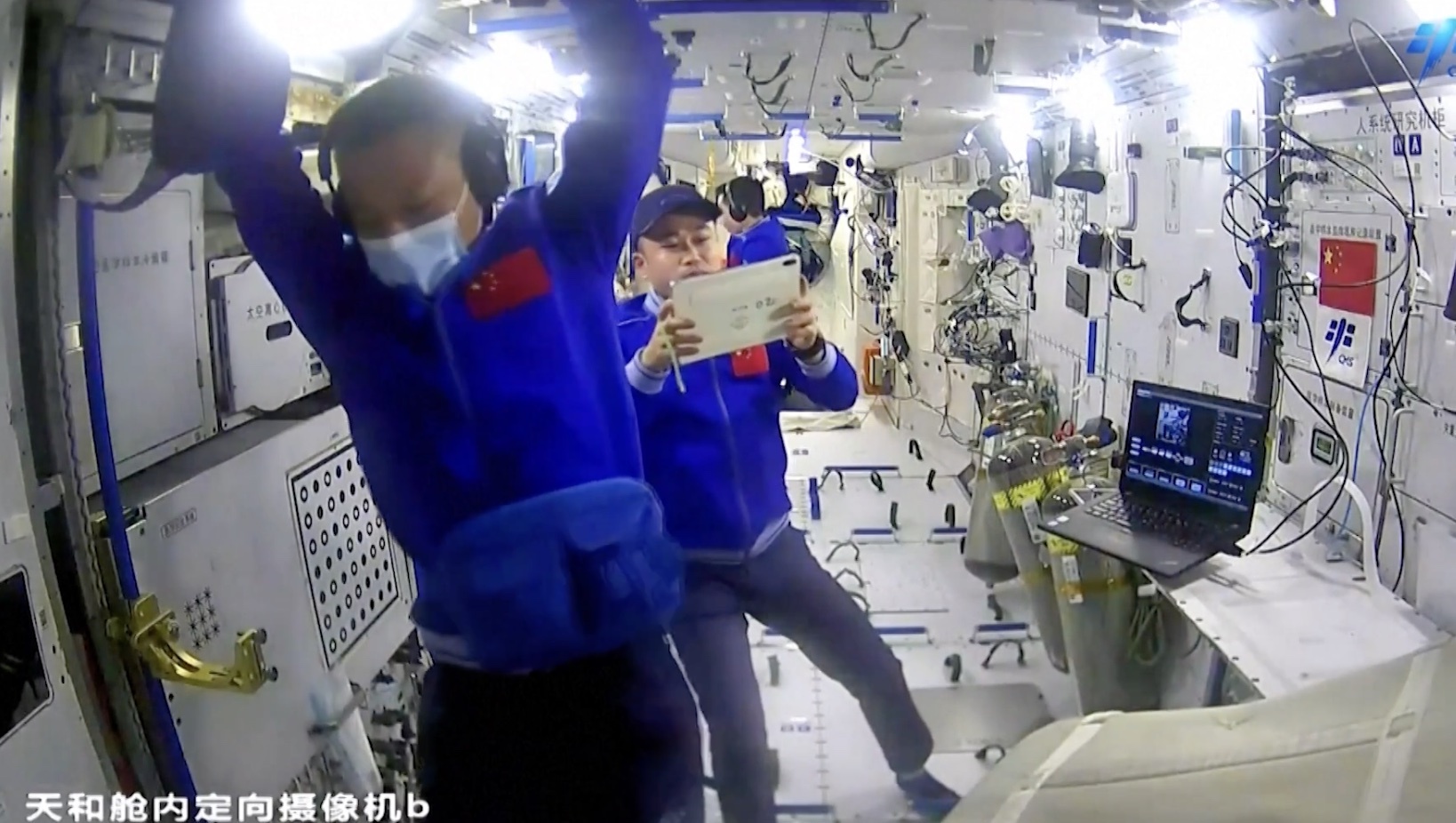
China's Shenzhou 17 astronauts are getting into the rhythms of life in orbit — and also sending back some choice clips of their activities.
Shenzhou 17 arrived at the Tiangong space station on Oct. 26, where they were greeted by the outgoing Shenzhou 16 mission crew.
Mission commander Tang Hongbo, a veteran of 2021's Shenzhou 12 mission, and rookie astronauts Tang Shengjie and Jiang Xinlin have now been in orbit for three weeks and working well.
Their daily work includes moving equipment outside the space station for experiments, managing equipment and facilities and maintaining science facilities for long-term research, according to a report from Chinese broadcaster CCTV.
The Shenzhou 17 astronauts have also conducted "medical care skill training" to boost their physical fitness and meet the demands of living in orbit.
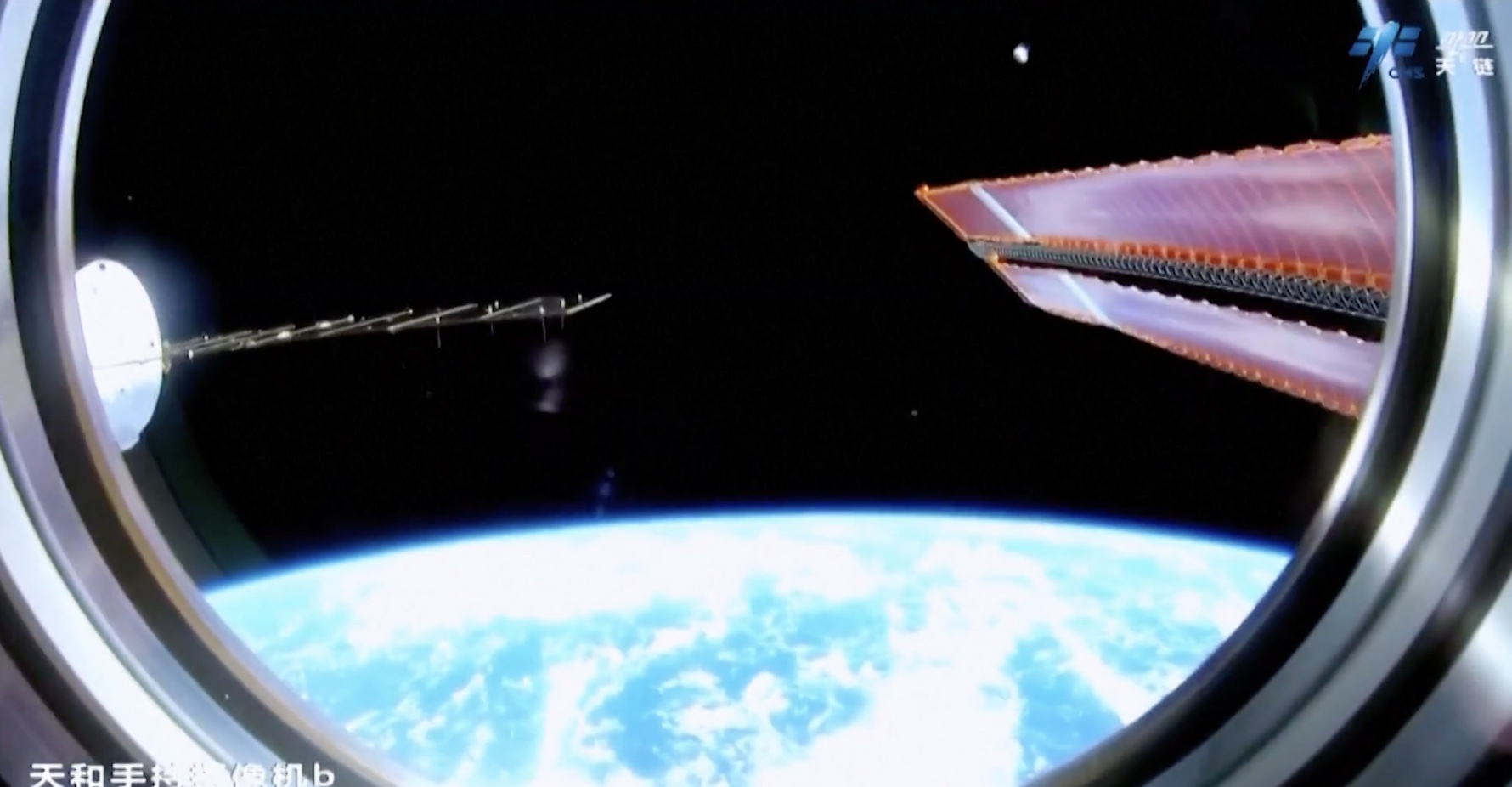
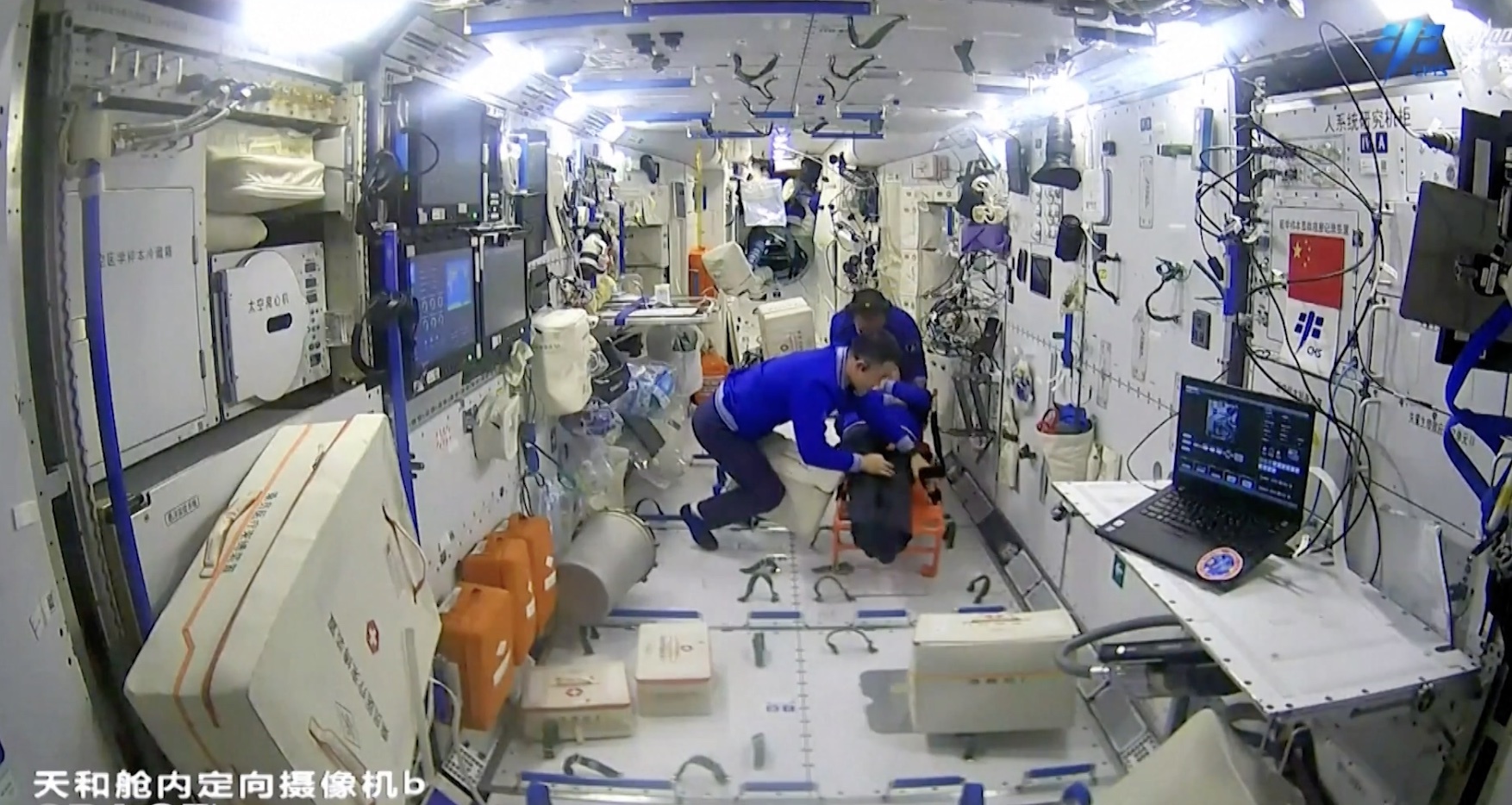
China's human spaceflight agency recently released footage of the crewmembers as they ate and exercised. The astronauts also captured their own footage, including a view of their Shenzhou 17 spacecraft docked with Tiangong.
The trio are expected to spend another five months in orbit. They will welcome the arrival of a new cargo spacecraft, Tianzhou 7, in early 2024. They are also reported to soon conduct their first extravehicular activity, or spacewalk.
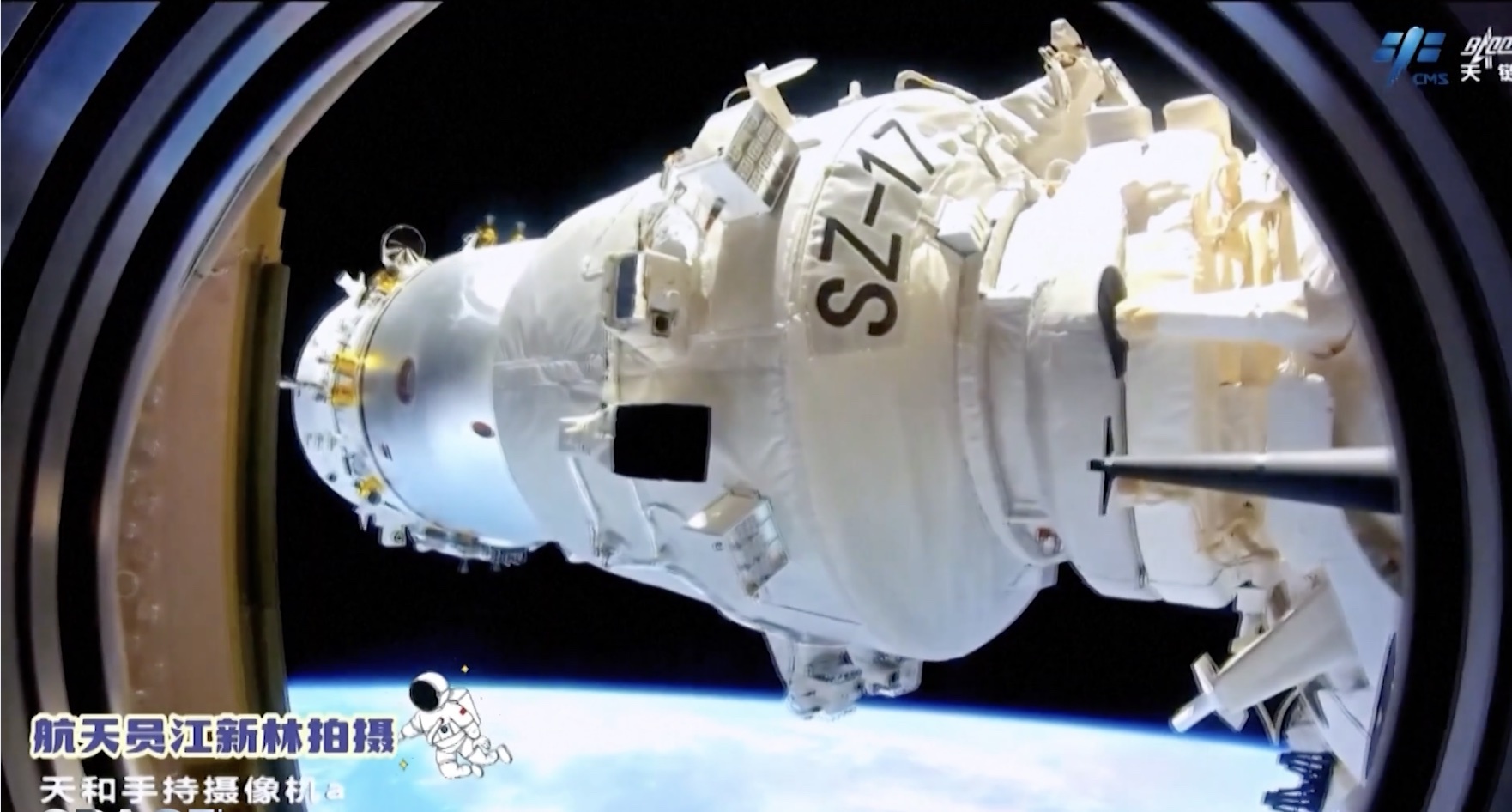
China's Shenzhou 17 spacecraft is shown here docked to the nation's Tiangong space station in late 2023. (Image credit: CCTV)
Quelle: SC
